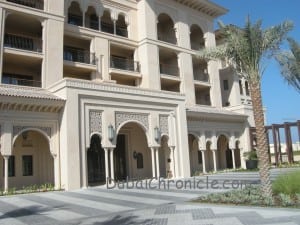
The largest travel and tourism event in the region, Arabian Travel Market, opened Monday at the Dubai International Convention and Exhibition Centre with more than 2,500 exhibitors and 70 national and regional pavilions. The 22nd edition of ATM puts a spotlight on family show and introduces a new Travel Tech Show and only on its first day, an array of new hospitality projects was revealed.
This year, ATM is even bigger and better. Running through Thursday, it comes with more exhibition floor space, more pavilions, and new launches for the expected 23,000 visitors. Of course, major companies used the event to announce their upcoming plans and to bring updates on hotels and amusement parks already in development. In fact, the first day of ATM was quite fruitful, when it comes to new project announcements. Moreover, each and every project revealed was in the high-end segment of the sector – luxury hotels with 5-star ratings, fancy restaurants,
The 700-room mixed-use Viceroy Hotel on The Palm, which is set to open in 2016, is now in its last phase when the bridge between its two sides is to be built. The 170-key net zero energy Hotel Indigo, which is now under construction in Dubai’s Sustainable City will open in 2017. Besides being environmentally-friendly, as 100% of its power will come from solar panels, the hotel will also be ultra modern and expensive. Rixos Hotels said their second Dubai project will include hotel space, residential apartments, and plenty of dining outlets once it opens next year. Although the group admitted that the market for luxury hospitality in the city is “substantially oversaturated”, they are still working on an unconventional and innovative 5-star hotel.
 Burj Al Arab’s Jumeirah Group revealed the name of its new hotel at the Madinat Jumeirah – Jumeirah Al Naseem. The luxurious 430-room property is expected to open in 2016. Another hotel to open next year in Dubai is the second project by Four Seasons Hotels and Resorts, which will be located in the Gate Village area in Dubai International Financial Centre and will have less than 100 rooms.
Burj Al Arab’s Jumeirah Group revealed the name of its new hotel at the Madinat Jumeirah – Jumeirah Al Naseem. The luxurious 430-room property is expected to open in 2016. Another hotel to open next year in Dubai is the second project by Four Seasons Hotels and Resorts, which will be located in the Gate Village area in Dubai International Financial Centre and will have less than 100 rooms.
However, along with the luxury hospitality projects, there was also an announcement for a more affordable resort. Developer Nakheel in partnership with the Spanish RIU Hotels & Resorts will build an all-inclusive beach resort at the massive 15,3-square-km Deira Islands. The 4-star waterfront development will feature 750 rooms and will cater to families who prefer pre-paid holiday packages rather than luxury and business-focused hotels.
All these projects are actually just a tiny part of what is planned for the next four or five years in Dubai. In 2012, the number of hotel rooms in the emirate stood at around 80,000, with occupancy rates around 80%, which is considerably higher than the regional average of 64% and 56% in Europe. According to the Dubai Tourism and Commerce Marketing, the city will need to increase the number of beds to 160,000 in order to be able to accommodate the 20 million tourists it aims to attract annually by 2020. The goal for that year, when the city is hosting the World Expo, is 25 million visitors. To many, this sounds quite ambitious, but the numbers are actually quite realistic, considering that each year, Dubai attracts over a million tourists more than the previous year. The growth in the travel and hospitality sectors is rapid, but will it be enough?
Some analysts point out that Dubai’s new hotel boom is far from sustainable. The problem is not in the number of rooms, but rather in the prevalent hotel category. Developers here obviously prefer 4- and 5-star hotels and resorts, which has created a unique international image for Dubai. But in reality, it’s not all glitz and glamour. Most people across the world – logically, most tourists, as well – are not millionaires. They are looking for affordable holiday packages, flight deals, all-inclusive resorts, and cheaper hotels. It’s true that Dubai is one the rich’s favourite leisure destinations, but it doesn’t mean each year 20,000 rich people will choose the emirate’s beaches. They most likely won’t.
And it’s probably reasonable to ask – why Asian or American tourists would choose Dubai as their shopping destination, when the Euro is now cheaper? Holidays in top European destinations turn out to be more affordable, not to mention popular destinations across Southeast Asia and emerging spots in China and South America. In order to attract more visitors, Dubai will need to offer not only glamorous shopping malls and huge theme parks. It will need to provide more affordable accommodation for families and average-income travelers, who would otherwise love to see Dubai for the first time. And just a word to local developers: 4-star hotels and resorts are by no means affordable.























![The Square at Nad Al Sheba Gardens Now Open hope tax season treated you well! Just checking in—ready to refocus on growing your business? I remember how we discussed scaling your [specific aspect of their business, e.g., online presence] but paused due to time constraints. We now offer a streamlined 6-month plan that delivers real results without adding to your workload. Let me know if you'd like to chat—I’d love to help you pick up where we left off!](https://www.dubaichronicle.com/wp-content/uploads/2024/11/The-Square-5-218x150.jpg)








